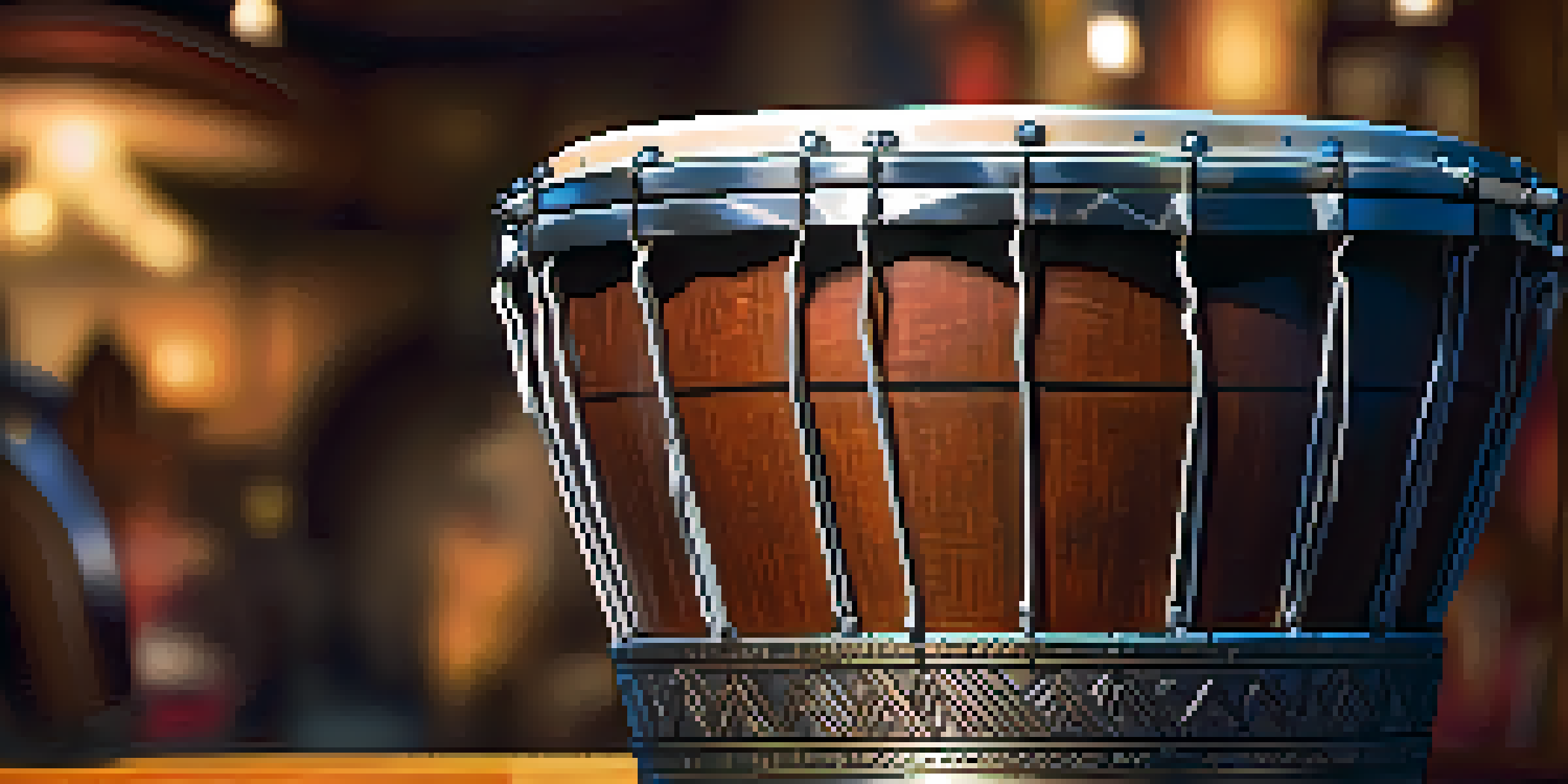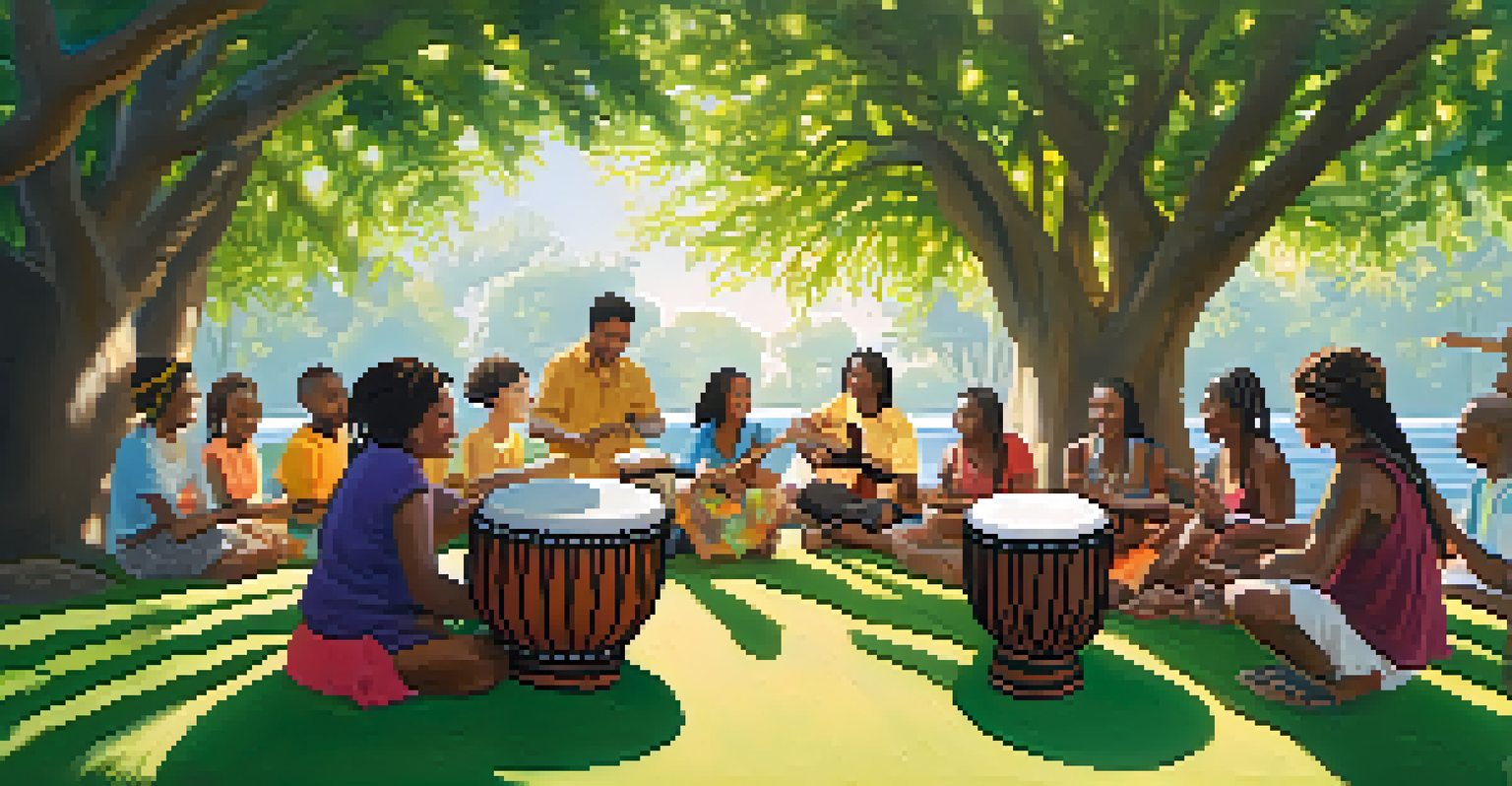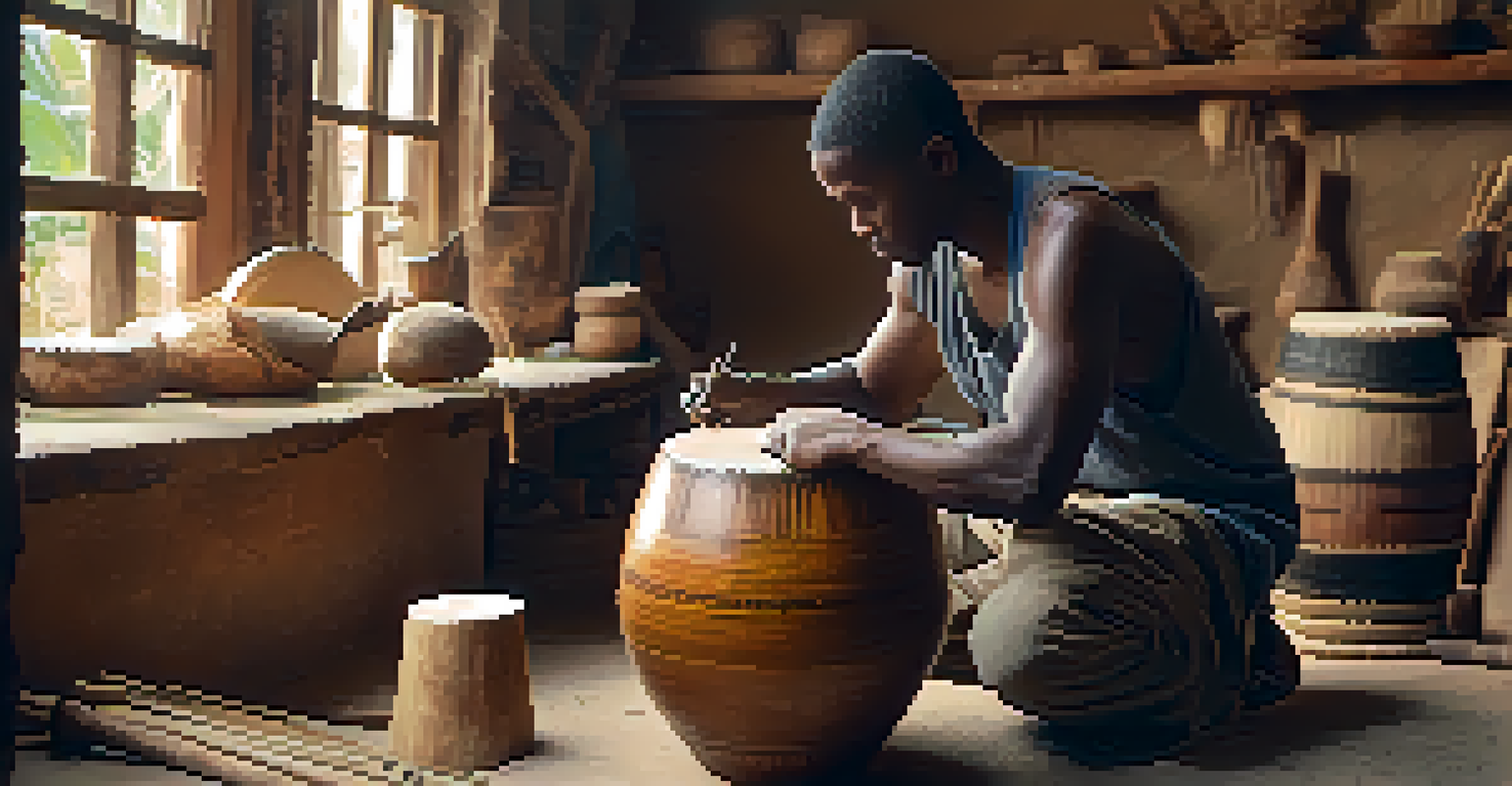Exploring the Djembe: A West African Percussion Instrument

What is the Djembe? A Brief Overview
The djembe is a goblet-shaped drum originating from West Africa, specifically from the Mandinka people of Mali. Traditionally made from a single piece of wood, it features a drumhead crafted from animal skin, which is stretched across the top. This unique design allows the djembe to produce a wide range of sounds, making it a favorite among percussionists around the world.
The djembe is a drum that speaks to the heart, a bridge between cultures and a celebration of life.
Often played at celebrations and gatherings, the djembe serves not only as a musical instrument but also as a means of storytelling. Each rhythm carries its own meaning, connecting the players and the audience to cultural narratives and shared experiences. In many communities, the djembe is seen as a bridge between generations, fostering a sense of unity and continuity.
With its deep roots in African culture, the djembe has transcended geographical boundaries, making its way into various musical genres globally. From traditional African music to contemporary fusion, this drum has earned its place in diverse musical landscapes, showcasing its adaptability and enduring appeal.
The Cultural Significance of the Djembe
The djembe is more than just an instrument; it is a vital part of West African culture. It plays a crucial role in rituals, ceremonies, and communal events, serving as a means to bring people together. Whether it's a wedding, a harvest celebration, or a naming ceremony, the djembe's rhythms create a sense of joy and togetherness.

In many West African societies, the drum is often linked to spiritual practices, where its beats are believed to invoke ancestral spirits. Drummers are seen as storytellers, using the drum to convey messages and celebrate life's milestones. This deep connection to spirituality and community underscores the djembe's importance beyond mere entertainment.
Cultural Significance of the Djembe
The djembe is a vital part of West African culture, used in rituals and celebrations to foster unity and convey stories.
Moreover, the djembe has become a symbol of identity for various ethnic groups. Its rhythms often reflect the unique history and traditions of the people, making it a powerful tool for preserving cultural heritage. By playing the djembe, individuals not only express their musicality but also honor their roots and share their stories with the world.
How the Djembe is Made: Craftsmanship and Materials
Crafting a djembe is a meticulous process that combines artistry and tradition. Typically, the drum body is carved from hardwood like mahogany or iroko, chosen for its density and resonance. The wood is often sourced locally, emphasizing sustainability and connection to the land.
Drumming is the secret language of the spirit, connecting us to our ancestors and to each other.
The drumhead, usually made from goat or cow skin, is carefully selected for its quality and texture. Once the skin is prepared, it is secured to the drum using rope or metal rings, allowing for tension adjustments. This careful construction ensures that the djembe produces a rich, vibrant sound that can resonate through a crowd.
Each artisan brings their own unique touch to the djembe-making process, often adding intricate carvings or embellishments that reflect their culture and personal style. This craftsmanship elevates the djembe from a mere instrument to a work of art, showcasing the skills and traditions of the community behind it.
Basic Techniques: How to Play the Djembe
Playing the djembe involves a variety of techniques that create its distinctive sounds. The most common strokes include the bass, tone, and slap, each producing a unique sound that contributes to the overall rhythm. Mastering these techniques requires practice and an understanding of the drum's dynamics.
The bass sound is created by striking the center of the drumhead with the palm, while the tone is achieved by hitting the edge with the fingertips. The slap, which is the sharpest and most pronounced sound, requires a quick, controlled strike from the fingers. Learning to combine these techniques allows players to create intricate rhythms and engage in call-and-response patterns.
Craftsmanship of Djembe Making
Creating a djembe involves meticulous artistry, with each drum showcasing unique designs that reflect cultural heritage.
As with any musical instrument, practice is key to becoming proficient on the djembe. Beginners often start by learning simple rhythms before progressing to more complex patterns. Joining a community drumming circle or taking lessons can provide valuable guidance and help accelerate the learning process, making it a fun and social experience.
Djembe in Modern Music: A Global Phenomenon
In recent years, the djembe has found its way into various music genres, transcending its traditional roots. From jazz and rock to pop and world music, this versatile drum adds a rich layer of rhythm and texture. Its infectious beats have inspired countless musicians to incorporate the djembe into their work, creating a fresh fusion of sounds.
Many contemporary artists and bands have embraced the djembe, using it to enhance their live performances. The drum's engaging rhythms encourage audience participation, creating an electric atmosphere that brings people together. It’s not uncommon to see djembe players collaborating with musicians from different backgrounds, showcasing the drum's universal appeal.
Additionally, the growing interest in world music has led to a resurgence of djembe classes and workshops worldwide. This has sparked a newfound appreciation for West African rhythms, allowing people from all walks of life to connect through the shared joy of music. As a result, the djembe continues to evolve, bridging cultures and inspiring creativity across the globe.
Learning the Djembe: Resources and Communities
For those interested in learning how to play the djembe, numerous resources are available to help beginners get started. Online tutorials, instructional videos, and drumming apps offer valuable insights into techniques and rhythms. Many of these resources cater to different learning styles, making it easy for anyone to find the right fit.
Joining a local drumming group or taking classes with experienced instructors can greatly enhance the learning experience. These communities provide not only guidance but also the opportunity to play with others, which is essential for developing rhythm and timing. Many drumming circles foster a supportive environment where players can share their passion and learn together.
Djembe's Role in Modern Music
The djembe has transcended its traditional roots, becoming a popular instrument in various genres and fostering global musical collaboration.
Additionally, attending workshops and festivals dedicated to West African music can provide a deeper understanding of the djembe's cultural significance. These events often feature performances, hands-on drumming sessions, and discussions led by experienced musicians. Immersing oneself in these experiences can ignite a lifelong love for the djembe and its rhythms.
Conclusion: The Djembe's Enduring Legacy
The djembe is more than just a percussion instrument; it is a vessel of culture, history, and community. Its rhythms have the power to unite people, evoke emotions, and tell stories that span generations. As the djembe continues to inspire musicians and listeners alike, its legacy remains vibrant and relevant in today's world.
In a time when the world feels increasingly fragmented, the djembe serves as a reminder of the beauty of connection. Whether played in a small gathering or a large festival, its beats resonate with joy and celebration, inviting everyone to join in the rhythm. The djembe's ability to adapt and thrive in diverse musical landscapes speaks to its universal appeal.

As we explore the rich history and cultural significance of the djembe, let us remember that it is not just about the music but the community it creates. So, whether you're a seasoned drummer or a curious beginner, picking up a djembe can lead you on an exciting journey of sound, rhythm, and connection.